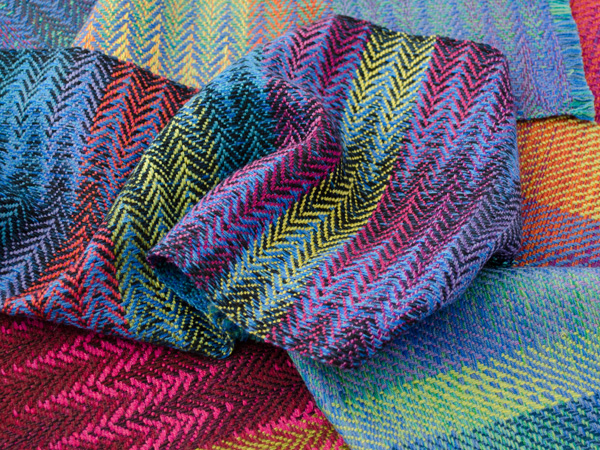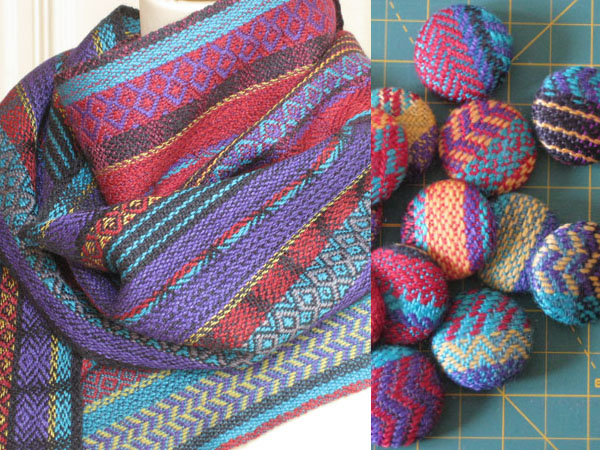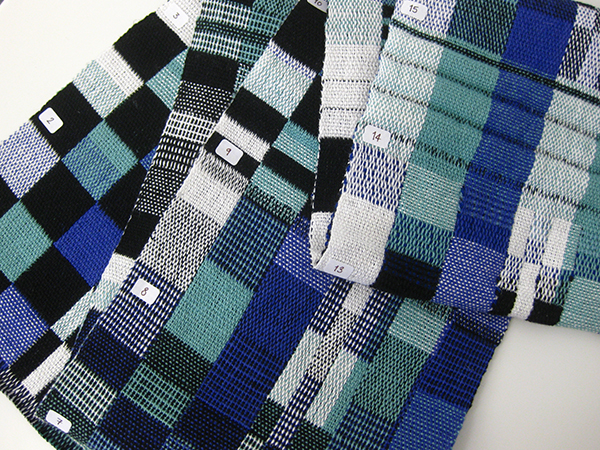If you ask almost any experienced weaver to share their top weaving tips, they will probably say “sample!” If you ask them what sett you should use for a particular project, they will probably say “sample!” If you ask them how much shrinkage you can expect from a certain yarn, they will…well, you get the picture. It can be frustrating for the new weaver who just wants a simple answer to a simple question, but there is no doubt about it: sampling is a great way to learn, and making it part of your weaving practice can really enhance your enjoyment of the craft.

Selection of handwoven samples
Objections to sampling
Let’s get these out of the way first. There are two main obstacles to sampling that weavers sometimes raise. The first is the cost: “Yarn is expensive, I don’t want to waste it on sampling.” Yes, yarn can be expensive – for me that is even more of a reason to weave a sample! I don’t want to risk ruining a whole project when a little sample could have saved me from making a costly mistake. The second is the idea that sampling is somehow self-indulgent: “I’m a practical person and I can’t weave anything that isn’t useful.” I have news for you — investing time and effort in your skill and knowledge as a weaver is useful.
If you build up a portfolio of woven samples then it will be one of the most valuable resources you have for planning future projects. On the other hand, if you really feel obliged to put every piece of fabric you weave into service as a finished object, then there are plenty of options. I have made ex-samples into needlecases, coin purses, covered buttons and more, and I am sure you can think of many more ideas!

The samples I wove before making these scarves became covered buttons
Strategies for weaving samples
So how should you tackle weaving samples? Well, it depends on your particular goal. There are two main approaches which I use.
1. Sampling for a weaving project
You have a particular project that you want to weave. You know what yarn you want to use and have chosen the weave structure. You are ready to start but feel a bit hesitant: will this sett be quite right for this warp? Would I be happier with a darker/lighter/brighter weft color? This uncertainty is easily addressed through sampling. When you plan your warp, add in a little bit of extra length – how much is up to you, but I always make it at least 12 inches. That gives me enough for 6 to 8 inches of weaving and a little bit of waste. This will make a very modest difference to the warp overall, and will be enough for you to try out your plan before you commit to the project itself.
I mentioned that there would be a little bit of waste — this is because I always recommend cutting off your sample and finishing it before you continue. It’s always a good idea to do this, but it is especially important if you are weaving something such as a lace weave where the yarn will shift when you wash the fabric. On the loom it will be very hard to tell whether that sett is going to provide the light lacy cloth you had in mind! You can minimize the waste by lashing your warp onto the front apron rod rather than tying it on.
Once you have washed and pressed your sample, pin it up somewhere so you can see it from a distance, walk around it and look at it from different angles. I use a piece of string tied to my warping board (there’s almost always one lurking there!) and a few curtain clips. It’s not a polished display piece — it’s a work-in-progress.

Alternative weft colors pegged up for evaluation
Now is the time to be brutally honest with yourself: do you need to change something to get a better result? If so, then won’t you be glad you sampled?
If I can, I will keep the sample (or samples) pinned up while I weave the project as a prompt to remind me what I am aiming for.
2, Sampling to learn weaving skills
The second kind of sampling is when you want to expand your horizons as a weaver and need a place to practice. It may be that you want to explore color interactions or perhaps you plan to learn a new weave structure. I also tend to start with a sampler when I am trying a yarn I have never used before. I want to find out how it will behave in my favorite weave structures and, crucially, what it will be like when the cloth is wet finished.

The picture above shows a sampler I wove to explore double cloth blocks on eight shafts. I spent a long time working on it with a book propped open beside the loom, making notes as I went. It was hard work, but that sampler helped me to fix in my mind the way that the structure worked. You can see that I have put numbered labels along the length of the piece: these correspond to my weaving notes. This little sampler is an invaluable part of my portfolio and it will never be made into anything else!
So as you can see, I am a big fan of sampling for weaving. I wasn’t always one, though. At first I had to be pushed and shoved into weaving samples, but now – confession time – I must admit that it is my favorite part of the process!

I am new to weaving but have falling in love with the process, choosing yarns that would work for new weavers I have a Ashford samplelt loom 10' has become a small nightmare , what advice would you give to a new weaver about choosing yarns?